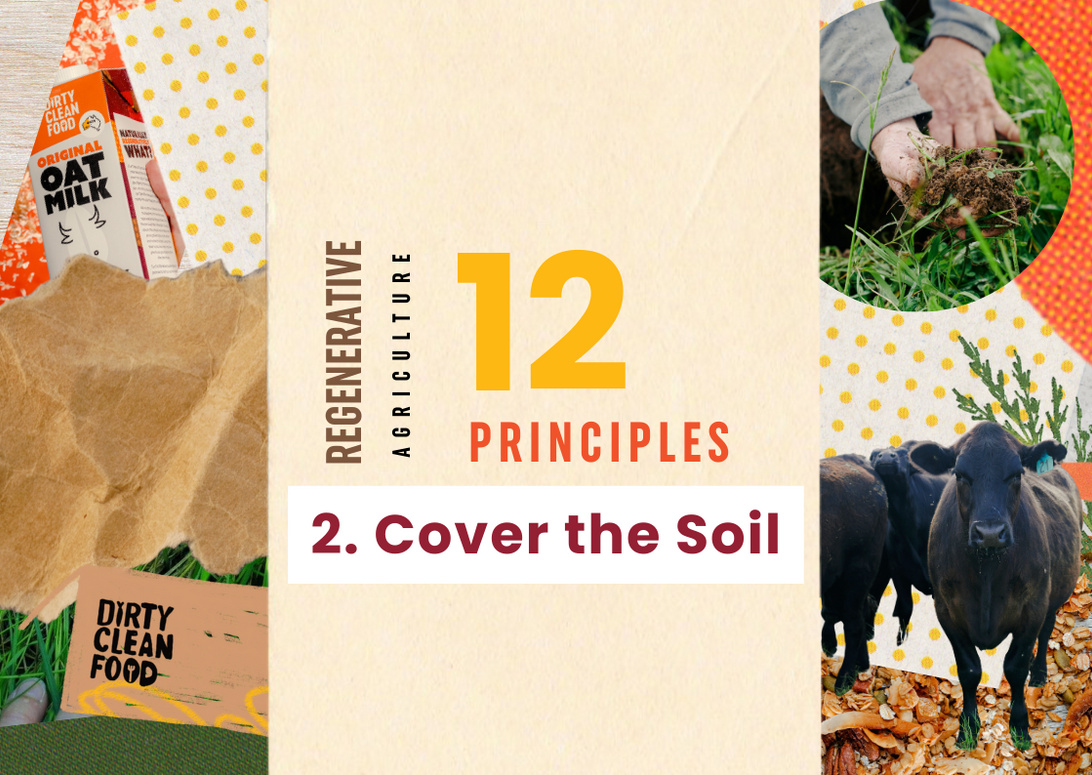
Regen Ag #2- Covering the Soil is Key!
|
Time to read 4 min
|
Time to read 4 min
Welcome to our 12 Principles of Regenerative Agriculture series- where we define "regen ag" and show you how regenerative farming changes the planet, the system, and our food.
We're going to break down our second principle, 'cover the soil'. Specifically, keeping the soil covered year-round, why we need to do this as part of regenerative farming, and how some of our farmers are covering the soil year 'round.
The best soil retains moisture so all things can grow- microbes, critters and crops. Think of the way that mulch works in your garden – keeping your plants cool and reducing evaporation from the soil surface. Keeping the soil covered in farming systems works the same way. A mulch layer or a covered soil reduces evaporation, reduces soil surface temperature, limits runoff and protects the soil from wind erosion.
Up to 80% of rain that falls on bare soil will evaporate before or shortly after it soaks into the topsoil.
Evaporation is dramatically reduced when the surface of the soil is not heating up by absorbing the sun's rays. Rain will soak through the mulch layer to the soil, and more of it will then stay in the topsoil, even when the sun is out again.
In a paddock, soil surface temperatures under residue-covered soils can be as much as 40 degrees cooler than bare tilled surfaces. This protects the soil and the soil microbes from heat, and helps to keep their soil habitat cool and a place they’re going to thrive. A mulch layer on the soil will also help to reduce runoff. When a deluge of rain hits the soil all at once, the mulch will absorb the rain, and help to slow down it’s horizontal movement down a slope, which gives it more time to sink into the soil and go down rather than across the soil surface.
Wind erosion has the potential to completely remove topsoil and deposit it elsewhere, along with blowing any moisture in the exposed soil away too. By leaving a mulch layer or using living plants, both the soil and the moisture are kept at or below surface level.
A mulch layer is also a habitat for lots of little critters! When you notice Spiders, earwigs, and beetles on or just under the mulch, it means that there are plenty of smaller insects for them to prey on. These insects are often cycling nutrients by breaking down crop stubble. These animals are part of the ecological food chain that maintain larger animals such as birds and reptiles.
In a broadacre context, such as growing the lovely oats that make our Dirty Clean Food Oat Milk, Keeping the soil covered year-round includes both cover from living plants, and residue leftover after that crop has been harvested. Steve Ford grows a lot of biomass through his oat crops, so most of his summer cover is the stubble leftover from his winter crops. Harvesting the oats with a stripper front on his harvester maintains as much of the stubble as possible. Sheep are then used to graze the stubble, as the animals trample down the oat plants to form a dense mat that covers the ground and acts like a layer of mulch over summer. It also means refraining from burning stubble in autumn, and instead using a disc seeder to seed the oats crop, which is able to cut through the thicker stubble much better than knife points. You can see how every aspect of regenerative farming works in relation to one another, and in harmony to uphold our 12 principles.
In the right season, Steve will grow opportunistic multi species summer cover crops. Taking advantage of summer thunderstorms, they seed a mix such as sunflowers, millet, sorghum and buckwheat, which will grow for as long as there is available moisture. These cover crops provide the dual benefits of cover and feeding the soil biology – more on that in our next feature, principle number 3 – Maintain living roots year-round.
In a pasture system such as at Runnymede farm, Keeping the soil covered focuses more on trying to keep more living plants covering the soil. This is because Blythe and Gregg can receive more summer rainfall at Harvey, and because they have access to flood irrigation. They are aiming to establish a multi species perennial and annual pasture for their cattle and chickens. A combination of living plants and lignified or dried plants form the previous season provide their cattle with the energy, protein and roughage they need to grow well.
You might remember from our previous post, the core of Runnymede Farm's pasture is kikuyu, which provides a dense covering on the soil – so dense that it can be hard for other plants to take root! The green leaves of the kikuyu are protruding from a denser layer of thatch, the buildup of dead plants from previous seasons. They are seeding a mix of chickory, plantain, ryegrass and clover into these paddocks to boost diversity, and get summer active perennials growing through the kikuyu. The winter active annuals, such as the clover, also provide diversity, while fixing nitrogen, and growing when the summer pasture slows down in the cold weather.
We hope you’ve enjoyed learning more about what it means to be a Dirty Clean Food regenerative farmer, and we look forward to showing you more in our next feature on 'Principle 3: Living Roots'.
‘Regenerative agriculture is an ecological approach to farming that allows landscapes to renew themselves.’



